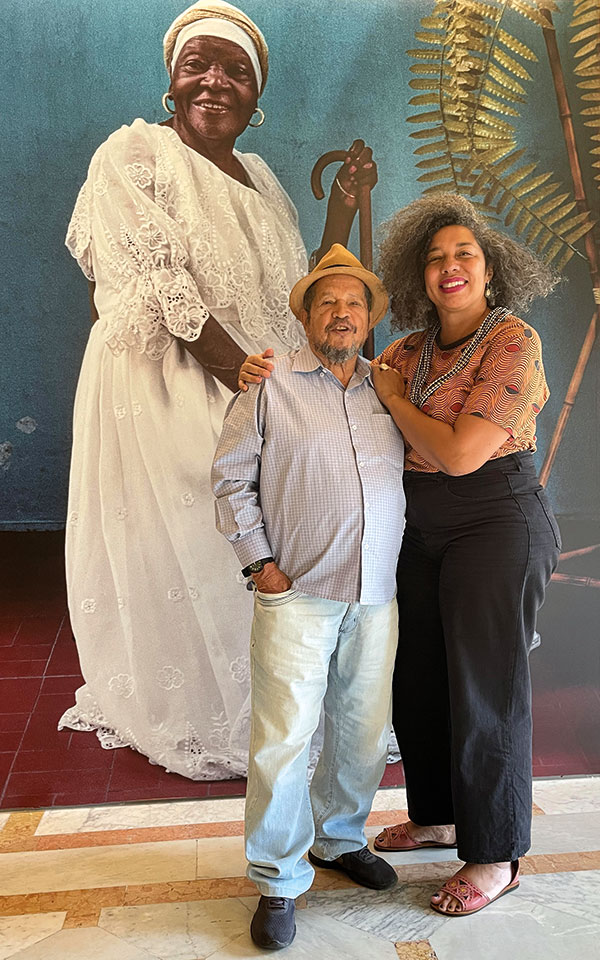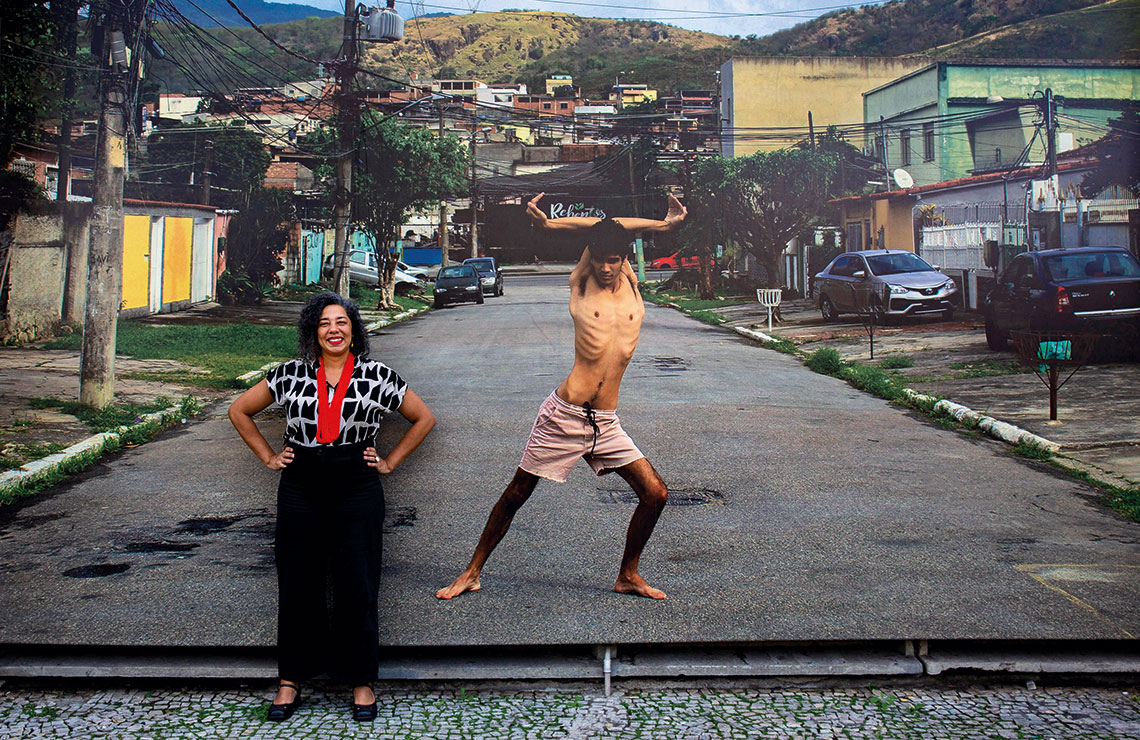I have always considered myself a lucky person — starting with my birth, when I was adopted as a baby by Dona Íris, an illiterate Black woman. Her story is similar to most Black women of her time: one of great struggle. She was born in 1919 to a family of workers who left Paraíba for Curitiba, in Paraná. Forbidden from studying, she was exchanged for a horse in what many would call a “dowry,” but I think that is an inadequate word to describe what happened. She revolted and fled from her arranged marriage to the interior of São Paulo, where she worked as a maid, cleaner, and housekeeper. When she went back to Curitiba, it was with Silvia, my older sister, who raised me after Dona Íris died in the early 1980s, when I was just 8 years old.
I was lucky to study in good public schools, but at home, my family thought it was strange that I wanted to study all the time. At the time, I was already thinking about going to college, but my sister tore up the application form for my first college entrance exam. She would not accept my dream. She said to me, “Who do you think you are, wanting to go to university?” Poverty, sexism, and racism stop Black families from seeing themselves in other places.
That’s when I discovered cinema as a refuge. I found out that I could watch films for free at the Curitiba Cultural Foundation’s movie theaters, and I watched entire Japanese films. Ironically, it was poverty that gave me access to the best of the world’s cinematography. And the movie theater was a place where I felt safe. After class, I would go to the public library and then to the movies, and I would stay in the theaters until they closed.
In 1994, I started studying philosophy at the University of Campinas (UNICAMP). This changed not only the course of my life, but also my family’s understanding that our world could be bigger. It was amazing to go into a cultural environment like that. I made friends and a love that last to this day. I made the most of all the social policies that the university offered: housing, food, scholarships. At that time, there were no quotas or affirmative action programs for Black people. The topic was not even under discussion and the situation was very different back then: I studied at an extremely white and elite university. Black people represented a very small portion of the students, and women were a minority. The books we studied were mostly written by white, male thinkers.
I decided to start a film production company with my classmates. In the early 2000s, I directed an animated film with Victor Epifanio called Roteiros negros (Black scripts). Then the debate about quotas began. That’s when I started directing a documentary with Rodrigo Braga called Elas são pretas (They are Black women), about the daily life of Black women studying at UNICAMP. During the process, my production company was robbed — they took some of the material we had recorded, as well as our cameras, our computer, everything.

Personal archiveJanaína Damaceno with photographer Walter FirmoPersonal archive
Because I had already transcribed what had been recorded, I thought, “this could be my master’s project.” The material was the starting point of my dissertation “Elas são pretas: Cotidiano de estudantes negras na Unicamp” (“They are Black women: The daily life of Black women studying at UNICAMP”), which I defended in 2008 at the university’s School of Education. I was supervised by anthropologist Neusa Maria Mendes de Gusmão, one of the most renowned scholars of quilombola communities in Brazil. One of the chapters of my dissertation led me to sociologist and psychoanalyst Virgínia Leone Bicudo (1910–2003). She changed the trajectory of my academic life.
Virgínia Bicudo was the first Black woman to earn a sociology degree in Brazil. No one had yet written a thesis on her contributions to the field of racial studies, despite her work being fundamental to understanding the nature of racism in Brazil. Her dissertation “Estudo de atitudes raciais de pretos e mulatos em São Paulo” (“Study of racial attitudes among Black people and people of mixed race in São Paulo”), defended at the Free School of Sociology and Politics (ELSP) in 1945, was supervised by American sociologist Donald Pierson (1900–1995). Bicudo spoke with Black mothers, intellectuals, and workers, who told her about their daily experiences relating to race. They discussed topics such as the loneliness experienced by Black women. Seeing how her work was erased from bibliographies helped me understand how difficult the process of affirmation and survival is for Black intellectuals in Brazilian universities.
In 2013, I completed my doctoral thesis “Os segredos de Virgínia: Estudo de atitudes raciais em São Paulo (1945–1955)” (“Virginia’s secrets: A study of racial attitudes in São Paulo [1945–1955]”) for my PhD in social anthropology at the University of São Paulo (USP), supervised by Professor Kabengele Munanga. The following year, during my postdoctorate in sociology at the Federal University of São Carlos (UFSCar), I investigated visual archives with the aim of understanding why some countries, such as the USA, have such extensive visual chronicles of the fight against racism. I visited archives in South Africa, where many Black photographers documented the apartheid, including Peter Magubane, Bob Gosani, Ernest Cole (1940–1990), and Santu Mofokeng (1956–2020). I asked myself, “where are the images of the Black struggle in Brazil?”
Eight years ago, I became a professor at the Baixada Fluminense College of Education at the State University of Rio de Janeiro (FEBF-UERJ) in Duque de Caxias. Around the same time, my son Omar was born. Being a mother, professor, and researcher in a country where academia is not designed for women was and is a major challenge. Another challenge is working at a college location on the outskirts of the city, the faculty of which is composed mostly of Black working-class women and people who live in the local communities. I often say that our college is like a quilombo.
As part of the Postgraduate Program in Culture and Territorialities at Fluminense Federal University (PPCULT-UFF), I supervise master’s students from the Research Group for Afrovisualities: Aesthetics and Politics of the Black Image. I am also involved in the Itinerant Black Cinema Forum (FICINE), which I helped create in 2013 and is now one of the world’s most important settings for discussing the topic. For example, it took me to the Journées Cinématographiques de la Femme Africaine de L’image (2014) in Ouagadougou, the capital of Burkina Faso, an event that includes film screenings, debates, and workshops. Together with researcher and curator Janaína Oliveira, a colleague from FICINE, I spoke at a discussion about Brazilian cinema and organized an exhibition of photos of Black women who work in our audiovisual sector as actresses, screenwriters, and directors.
Later, I was assistant curator of Brazilian photographer Walter Firmo’s exhibition No verbo do silêncio, a síntese do grito, which opened in 2022 at the Moreira Salles Institute in São Paulo and has been visiting other Brazilian cities. It is currently on display in Belo Horizonte. Curating offers a chance to deconstruct the colonized discourse that exists in the artistic field. I do not want to miss this opportunity. I recently started getting involved with raising awareness of the work of photographers who have received little attention. One was a photojournalist called Sebastião Marinho, an 85-year-old Black man who photographed six World Cups and has an incredible catalog of work. I wonder how many other names we are yet to discover.
Republish